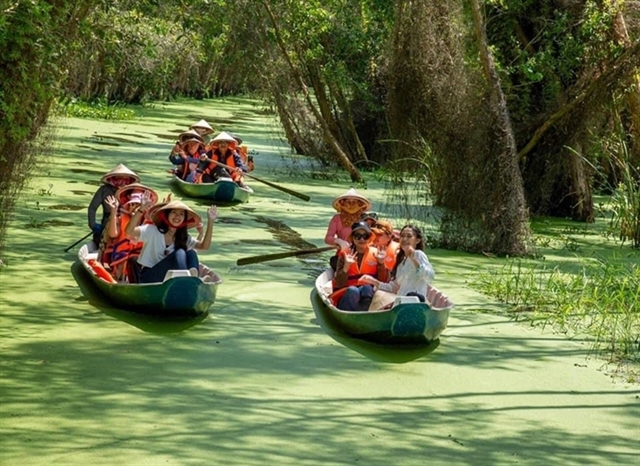 Society
Society

The southern province of Long An is shifting to more sustainable tourism models and investing in new technologies to help recover its tourism sector.

|
| The Tân Lập floating village eco-tourism area in Mộc Hóa District’s Tân Lập Commune is a peaceful destination with charming river scenes and Melaleuca forests. Photo courtesy of the Long An Department of Culture, Sports and Tourism |
HCM CITY — The southern province of Long An is shifting to more sustainable tourism models and investing in new technologies to help recover its tourism sector.
Nguyễn Tấn Quốc, deputy director of Long An Department of Culture, Sports and Tourism, said the province plans to focus on eco-tourism and other activities while ensuring pandemic safety.
As a member of the Tourism Promotion Organisation for Asia Pacific Cities (TPO), the provincial tourism department has recommended policies that would support travel firms, such as rent reduction or exemption and lower value-added taxes on tourism activities.
Other policies would reduce environmental taxes for travel firms and lower taxes for tourism business households in 2021.
Conferences with provincial leaders and related agencies will also be organised to remove difficulties for tourism businesses. Tourism linkages with Hồ Chí Minh City and Mekong Delta provinces to promote new tourism products will also be created.
Long An has over the years called for investment in tourism projects, especially green or eco-tourism products, and in human resources.
Travel firms have also been urged to use technological innovation to create highly competitive tourism products in the province and in the entire Mekong Delta region.
Phan Tấn Hòa, deputy chairman of Long An People’s Committee, said Long An plans to promote programmes to tap tourism potential with HCM City. Travel firms in HCM City said they would offer customised tours to Long An such as weekend getaways to areas famous for ecotourism and river tourism.
Niche markets
Long An is trying to shift to niche markets, including adventure travel and health and wellness tours. The province has a favourable geographical location with diverse and rich tourism potential, especially eco-tourism, entertainment tourism, weekend getaways and rural tourism.
Under a project on tourism development to 2030, Long An will focus on ecosystem tourism in the Đồng Tháp Mười region. It will promote three major tourist attractions: Láng Sen Wetland Reserve, Tân Lập Floating Village Eco-tourism Area, and Đồng Tháp Mười Centre for Research, Conservation and Development for Medicinal Herbs.
The Láng Sen Wetlands Reserve is Việt Nam’s seventh RAMSAR site which preserves unspoiled natural features with limited human impact.
Covering 4,802ha in three communes of Vĩnh Đại, Vĩnh Lợi and Vĩnh Châu A (Tân Hưng District), the wetlands reserve is home to about 156 species of wild plants and 149 species of vertebrates, of which 13 are listed in the Việt Nam Red Book.
The wetlands reserve is popular with visitors, thanks to its natural beauty, fresh air and great food such as boiled snails, fried catfish, grilled snakehead fish with young lotus leaves, and sour soup of linh fish cooked with wild flowers.
The Tân Lập Floating Village Eco-tourism Area in Tân Lập Commune in Mộc Hóa District is another peaceful tourist destination with charming river views and Melaleuca forests. Visitors will find it peaceful sitting on a boat floating on the forest canal, smelling the melaleuca scent, and seeing the lotus and water lilies blooming in a corner of the river and the birds fluttering in the blue sky.
An observatory in the area boasts a panoramic view of the entire ecological area.
Visitors can also enjoy great food such as chicken hotpot with giang leaves, sour hotpot of snakehead fish, deep-fried reishi, braised perch, and eel stir-fried with turmeric, and take part in campfires and BBQs, picnics, and teambuilding.
The Đồng Tháp Mười Centre for Research, Conservation and Development of Medicinal Herbs is located near a primeval melaleuca forest with an area of more than 900ha, 21 species of higher plants and fauna typical of the original Đồng Tháp Mười region such as storks, herons and cranes.
The centre offers medicinal treatments such as tobacco baths, saunas, foot baths and others as part of its effort to develop ecotourism products.
In addition, the tourism floating season is a highlight organised during the flood season from August to the end of December every year.
Some specific activities that will be organised for tourists include visiting locals in the flood season and floating villages in the wetlands, and taking boat rides.
For waterway tourism on Vàm Cỏ river, there will be tours to experience the landscape in combination with visits to historical and cultural sites, farms and craft villages along both sides of the river.
Because of the COVID outbreak this year, the province has seen reduced revenues from tourism. Phạm Ngọc Trí, deputy director of the Tân Lập floating village eco-tourism area in Mộc Hóa District’s Tân Lập Commune, said that resorts in the area have had to close for almost five months with tourism revenue reaching only 20 per cent of the plan.
The ecotorism area will need time to restore the landscape and seek human resources to replace workers who have quit their jobs. It now has 50 employees but 37 employees are on leave and three have quit.
Long An Province welcomed about 270,000 local visitors (no international visitors) in the first nine months of the year, down 43 per cent year-on-year, according to the Long An Department of Culture, Sports and Tourism.
Tourism revenue was estimated at VNĐ140 billion (US$6.2 million) in the first nine months, down 50 per cent against the same period last year.
The province is expected to receive 350,000 local visitors by the end of the year, with tourism revenue estimated at VNĐ180 billion đồng, a drop of 58 per cent compared to 2020. — VNS